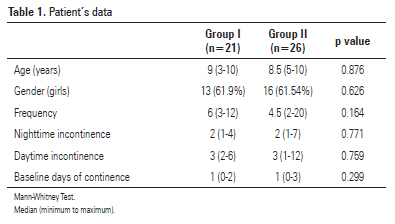OBJECTIVE: To verify and compare the results of behavioral modification plus pelvic floor muscle training and behavioral modifications plus oxybutynin chloride in children with nonmonosymptomatic enuresis. METHODS: A total of 47 children were randomized using opaque and sealed envelopes sequentially numbered. Group I was composed of 21 children who underwent antimuscarinic treatment (oxybutynin), and Group II was composed of 26 patients who underwent pelvic floor muscle training. Both groups were instructed as to behavioral modifications. RESULTS: The voiding diary results were compared each month between Groups I and II. In the first month of treatment, children in Group I presented 12.2 dry nights, 13.4 in the second month, and 15.9 in the last month. In Group II, the results were: 14.9 dry nights in the first month, 20.8 dry nights in the second and 24.0 dry nights in the last month. There was a significant difference between the groups in second and third months. CONCLUSION: Pelvic floor exercises associated with behavioral changes were more effective than pharmacological treatment in children with urinary incontinence.
Enuresis; Urinary incontinence; Physical therapy modalities








